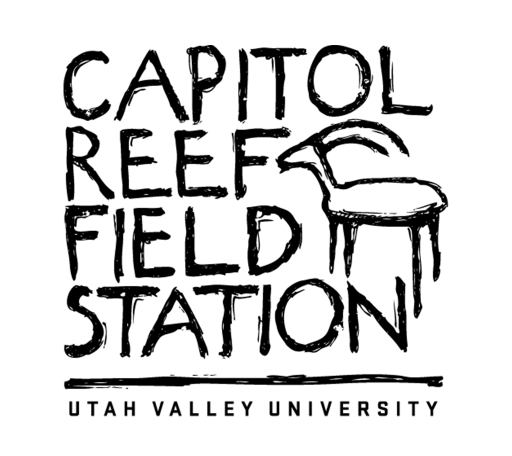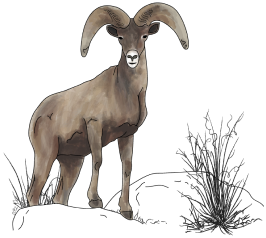Populus fremontii S.Watson
Viridiplantae > Streptophyta > Streptophytina > Tracheophyta > Euphyllophyta > Spermatophyta > Magnoliopsida > Mesangiospermae > eudicotyledons > Gunneridae > Pentapetalae > rosids > fabids > Malpighiales > Salicaceae > Saliceae > Populus > Populus fremontii [1]
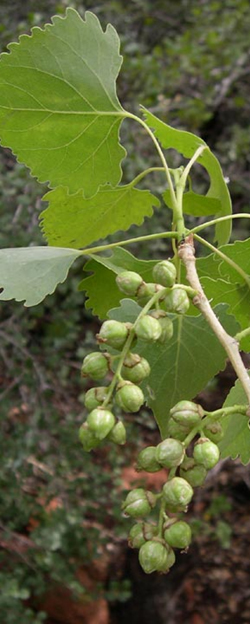
The mature fruit of Populus fremontii, not yet dehisced. Note the large size of the fruit and the deeply toothed margins of the leaves. Photo by Max Licher taken in Sedona, AZ [24].
Trees to 25 m tall with broad rounded crowns, the crown often as broad or broader than the tree is high, the trunk to 2 m in diameter. Bark smooth and whitish on young trees and on twigs and young branches, deeply furrowed and grayish or brownish on old trunks. Petioles (0.8)3-9.5 cm long, 1/2 to as long as the blade, flattened, rarely with 2 glands at the summit. Leaf blades (2)4-10 cm long, (15)4.5-12.5 cm wide, or much larger on sterile sprouts, 0.6-1.2 times as long as wide, deltoid, ovate, rarely nearly rhombic, with truncate, cuneate, or cordate base, acuminate apically, coarsely to finely crenate or serrate with ca 8-11(15) glandular teeth, glabrous, greenish or yellow green on both sides, turning yellow in autumn. Staminate aments 4-10 cm long, the flowers with a broad oblique disk and 50-80 stamens with dark red anthers. Pistillate aments 5-15 cm long, the flowers with a cup shaped disk, this to 5 mm wide in fruit. Capsules 7-10(12) mm long, to 8 mm wide, ovoid to subglobose, 3- to 4-valved, glabrous, the stipes 2-6(10) mm long. Stigmas strongly dilated and irregularly lobed [2].
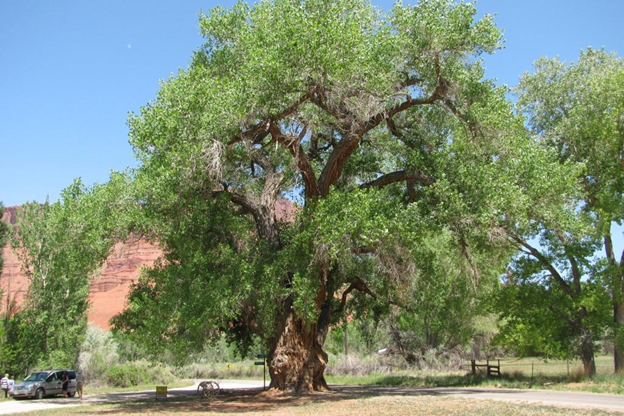
The Utah state champion Populus fremontii found growing in Castle Valley. Photo taken in 2016 by Jeran Farley [23].
Populus fremontii and Populus deltoides (Eastern Cottonwood) are very similar and are distinguished primarily by floral characteristics. In the Flora of North America they are separated as follows: P. deltoides (including P. deltoides ssp. wislizeni) has stamens 30-40(-55); pedicels 1-10(-17 in fruit) mm; ovaries ovoid, discs saucer-shaped, 1-3(-4) mm diam.; branchlets usually glabrous or thinly long-hairy. Comparatively,P. fremontii has stamens (30-)40-60(-70); pedicels 1-4(-5.5 in fruit) mm; ovaries spherical, discs cup-shaped, (2.5-)4-7(-9) mm diam.; branchlets glabrous, glabrate, or hairy [4]. While P. deltoides and Populus fremontii are, for the most part, separated by the Rocky Mountains, there are regions where the two species interbreed. In Eastern Utah, Colorado, and New Mexico an admixture of the two species is found [5].
Populus nigra (Black Poplar / Lombardy Poplar) specimens are introduced, cultivated, and sometimes persisting. Populus fremontii is distinguished from P. nigra by having bud scales and twigs which are of the season, pubescent and leaf blades commonly with 4-10(15) fine to coarse teeth on each side, whereas P. nigra bud scales and twigs are typically glabrous and have leaf blades with 15-25(30) fine teeth on each side. Further, P. fremontii has a broad crown whereas P. nigra is usually more columnar in shape.
Populus fremontii was first collected by John C. Fremont during his 1846 expedition to California, where they were collected on Deer Creek at ‘Lassens’ in the Upper San Francisco Valley [7]. The species was described as Populus fremontii S. Watson in 1875 [6]. Some botanists recognize this species as Populus deltoides var. fremontii (S. Watson) Cronquist [8].
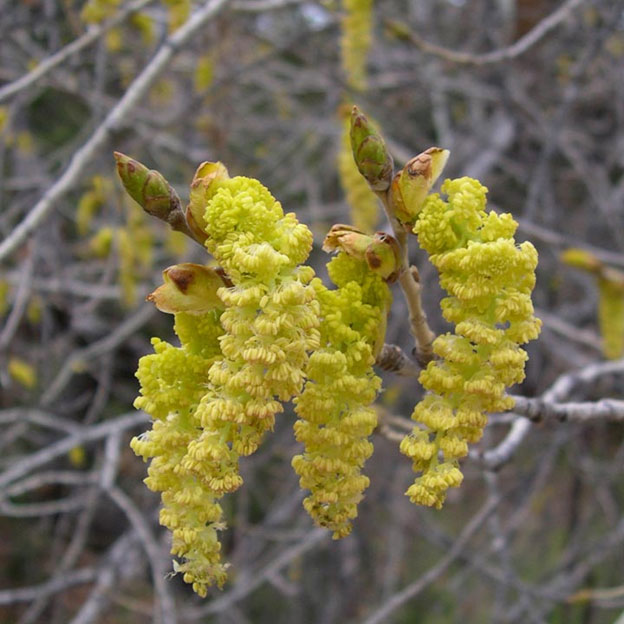
Male catkins of Populus fremontii filled with pollen. Photo by Max Licher in Sedona, Arizona. [13]
Populus fremontii is often used in landscaping and as a soil stabilizer, particularly in riparian restoration efforts [9], due to hardy wood that resists degradation, a reason it was also used by pioneers for fence posts [10].
Catkins can be eaten raw or cooked [11, 12] or as a snack [13]. Seed Pods, when young and green can be chewed as a gum [13]. The inner bark was used for man and horse in hard times, it is bitter but edible and can be scraped off, cooked in strips like soup noodles, or dried and powdered as a flour substitute [14]. The sweet and starchy sap can be consumed raw or cooked [14]. There are no known hazards toward inedibility [15].
Some Native American tribes ate the inner bark to prevent scurvy [12, 16]. The bark of most, if not all members of the genus, contains salicin, a glycoside that decomposes into salicylic acid (aspirin) in the body [17, 18]. The bark can therefore be used an a pain killer, anti-inflammatory and fever reducer. It is used especially in treating rheumatism and fevers, and for menstrual cramps [18]. A wet cloth wetted with an infusion of the bark and leaves is tied around the head as a treatment for headaches [13] and as a wash on cuts, bruises, wounds and insect stings [13]. A poultice of the boiled bark and leaves has been used to treat swellings caused by muscle strain [13].
The Hopi Indians of Arizona consider the cottonwood tree sacred and carve Kachina dolls from the roots of the tree. They believe the rustle of the wind through the quaking leaves to be the gods speaking to people [19]. The Chumash and Wintun tribes made skirts of fibers of Populus inner bark along with Asphaltum grass.
An extract of the shoots can be used as a rooting hormone for all types of cuttings. It is extracted by soaking the chopped up shoots in cold water for a day [20]. The young twigs are peeled and split then used in basket making [12, 13, 16].
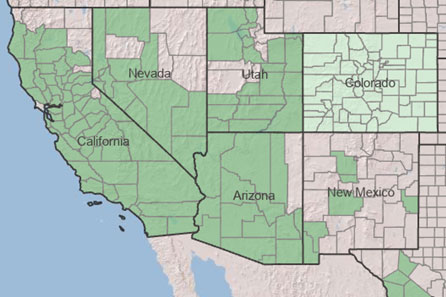
[3]
Fremont Cottonwood has most recently been assessed for The IUCN Red List of Threatened Species in 2018 and listed as Least Concern [21].
Populus fremontii is native to Utah and common along the drainages of the Colorado river system, and sporadic elsewhere. This plant can be found in warm desert biomes where it is localized to lower elevation riparian communities between 760 and 1860 m in its native range. Commonly found along floodplains of rivers and along washes, irrigation ditches, and occasionally cultivated [2].
[1] NCBI Taxonomy Database, https://www.ncbi.nlm.nih.gov/Taxonomy/Browser/wwwtax.cgi accessed 12 October 2022, search term “Populus fremontii”.
[2] Welsh, S. L. A Utah flora. 3rd ed., Brigham Young University Press, 2003. ISBN 0-8425-2556-4
[3] USDA NRCS National Plant Data Team. "Populus fremontii S. Watson Plant Profile." USDA Plants Database, plants.usda.gov/home/plantProfile?symbol=POFR2.
[4] Flora of North America Editorial Committee. Flora of North America: Volume 7: Magnoliophyta: Salicaceae to Brassicaceae: North of Mexico. Oxford UP, 2010, www.efloras.org/florataxon.aspx?flora_id=1&taxon_id=126537.
[5] Cushman, Samuel A., et al. “Landscape Genetic Connectivity in a Riparian Foundation Tree Is Jointly Driven by Climatic Gradients and River Networks.” Ecological Applications, vol. 24, no. 5, Wiley, July 2014, pp. 1000–1014. Crossref, doi:10.1890/13-1612.1.
[6] "Populus Fremontii S. Watson." Tropicos, Missouri Botanical Garden, legacy.tropicos.org/Name/28300123.
[7] American Academy of Arts and Sciences. Proceedings Of The American Academy Of Arts And Sciences, V. 10. Press of John Wilson and Son, 1875.
[8] Cronquist, Arthur, et al. Intermountain Flora Vol 2 Part B. Hafner Pub. Co., 2005.
[9] "NCRS Fact Sheet: Fremont Cottonwood, Populus fremontii S. Watson." USDA Plants Database, plants.usda.gov/DocumentLibrary/factsheet/pdf/fs_pofr2.pdf.
[10] Sargent. C. S. Manual of the Trees of N. America. Dover Publications Inc. New York. 1965 ISBN 0-486-20278-X
[11] Coon, Nelson. The Dictionary of Useful Plants. Rodale Press, 1974.
[12] Elias, Thomas S. The Complete Trees of North America: Field Guide and Natural History. Van Nostrand Reinhold, 1980.
[13] Moerman, Daniel E. Native American Ethnobotany. Timber Press (OR), 1998.
[14] "NCRS Plant Guide: Fremont Cottonwood, Populus fremontii S. Watson." USDA Plants Database, plants.usda.gov/DocumentLibrary/plantguide/pdf/cs_pofr2.pdf.
[15] Fern, Ken. "Populus Fremontii - S. Watson." Plants for a Future, pfaf.org/user/Plant.aspx?LatinName=Populus+fremontii.
[16] Usher, George. A Dictionary of Plants Used by Man. Macmillan Publishing Company, 1974.
[17] Weiner, Michael A. Earth Medicine, Earth Food: Plant Remedies, Drugs, and Natural Foods of the North American Indians. Ballantine Books, 1980.
[18] Bown, Deni. Encyclopedia of Herbs & Their Uses. DK Publishing (Dorling Kindersley), 1995.
[19] Strike, Sandra S. Ethnobotany of the California Indians: Aboriginal uses of California's indigenous plants. 1994.
[20] Schofield, Janice J., and Janice S. Eaton. Discovering Wild Plants: Alaska, Western Canada, the Northwest. Alaska Northwest Books, 1989.
[21] "Populus fremontii IUCN Red List Assessment." IUCN Red List of Threatened Species, www.iucnredlist.org/species/153746001/181465238.
[22] "Fremont Cottonwood, Castle Valley." Utah Community Forest Council, utahurbanforest.org/amazing-trees/big-tree-directory/item/1397-fremont-cottonwood-castle-valley.
[23] Farley, Jeran. "Giant Cottonwood Castle Valley.jpg." Photograph. Utah Community Forest Council, 2016, utahurbanforest.org/media/k2/galleries/1397/02%202012-05%20337%20Giant%20cottonwood%20Castle%20Valley.jpg.
[24] Licher, Max. "Populus fremontii SL web N2.jpg." Photograph. SEINet Portal Network, swbiodiversity.org/imglib/h_seinet/seinet/Salicaceae/photos/Populus-fremontii-SL-web-N2.jpg.
[25] Licher, Max. "Populus fremontii Fm web N0.jpg." Photograph. SEINet Portal Network, https://swbiodiversity.org/imglib/h_seinet/seinet/Salicaceae/photos/Populus-fremontii-Fm-web-N0.jpg
